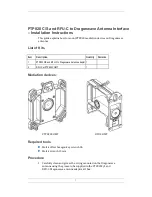
15 Carryout Antenna
Troubleshooting
Carryout Antenna 16
Finished Using the Carryout Antenna?
Connecting to the Cable TV Entry Port on Your RV
Maintenance
Alternate Power Supply Specifications
Generally, the port on the side of an RV is designed for cable TV. The cable from
this port runs through the wall plate for the over-the-air antenna or through a
video distribution system.
Satellite signals will not pass through these circuits. The only thing that can be
between the Carryout antenna and the satellite receiver is coax. Therefore, it is
important to make sure that the cable from the external port by-passes everything
and runs directly to the satellite receiver.
Go to http://www.winegard.com/kbase/upload/carryout_wiring.pdf for more
information on wiring the Carryout antenna.
Follow the steps below to prepare the Carryout antenna for travel or storage:
Unplug the Carryout antenna at the cigarette plug.
Unplug your satellite receiver(s).
Disconnect the coax cable for any receivers connected to the antenna.
Disconnect any coax cable connected to the Carryout base.
Coil the cables to make storage easier.
Unplug the quick disconnect power from the base of the antenna.
Coil the power cable for easy storage.
Issue
Possible Cause
The antenna does not attempt to
find a satellite, or it never moves.
Verify power source is pro12 VDC to the antenna.
Ensure that the quick disconnect power connector is fully
seated and locked into the quick disconnect socket.
The antenna continuously
searches and eventually stops
without ever acquiring any
satellites.
Verify the main coax cable from the antenna is connected to the
“Satellite In” port on the back of the receiver.
Verify all coax cables are properly terminated and that there are
no loose connections.
Check to see if the southern sky is clear. Trees, buildings, large
signs or an overpass can block the signal.
Rain, snow, or excessive dew on the dome can interrupt the
signal. Brush any snow or dew off of the dome. If heavy rain or
snowfall is blocking the signal, it may be necessary to wait until
the weather clears.
With DIRECTV, the dish will find
the alternate satellite but not the
primary satellite.
Make sure that the switches on the electronics control box are
set for DIRECTV. See page 2. These switches are found on the
electronics box under the dome.
I am not getting all of the DISH
channels that I subscribed to.
Go to the Check Switch Menu on the receiver. Make sure it is
set for SW64. Both even and odd transponders on satellite 110°,
119°, and 129° should be listed.
Local programming may not be available outside of your local
coverage area.
I have switched satellite service
providers. How do I set my dish
for my new provider?
Remove the dome, and set switches to correct provider. See
switch settings on page 2.
My receiver appears to be locked
up and is not responding.
DIRECTV users should reboot by
one
of the following methods:
Press the red reset button on the inside of the small door on the
receiver, OR unplug the receiver from AC outlet for 20 seconds,
and plug back in.
DISH users should reboot by
one
of the following methods:
Press and hold the power button on the receiver for 15 seconds,
and then release, OR unplug the receiver from AC outlet for 20
seconds, and plug back in.
The antenna appears to lock onto
signal, but my receiver does not
show a picture or signal reading.
Verify the switch settings are set correctly for the desired
provider. See switch settings on page 2.
DIRECTV users should verify the antenna type is set to either 3
LNB “18X20” or 2 LNB oval.
DISH/Bell users should verify the “Check Switch” installed in
the receiver; DISH users should verify this to be SW64, and Bell
users should verify this to be SW42. Note: a new receiver will
initially have an “Unknown Check Switch”, but the antenna will
still perform a search; however, it will not toggle to alternate
satellites.
The Carryout antenna is designed to be maintenance free. However, it is a good
idea to clean the dome from time to time with a soft cloth, water and dish soap.
1
2
3
4
5
6
7
•
DC Voltage range: 13–15 VDC
•
DC Voltage tolerance: 2–5% over
from 0% to 100% of rated load
•
Typical min. current range: 5–6 amps
•
Ripple and noise max: 100 mV p-p
•
AC input voltage range: 100–120
VAC
•
Frequency: 50–60 Hz
•
Integrated Cigarette Receptacle





























